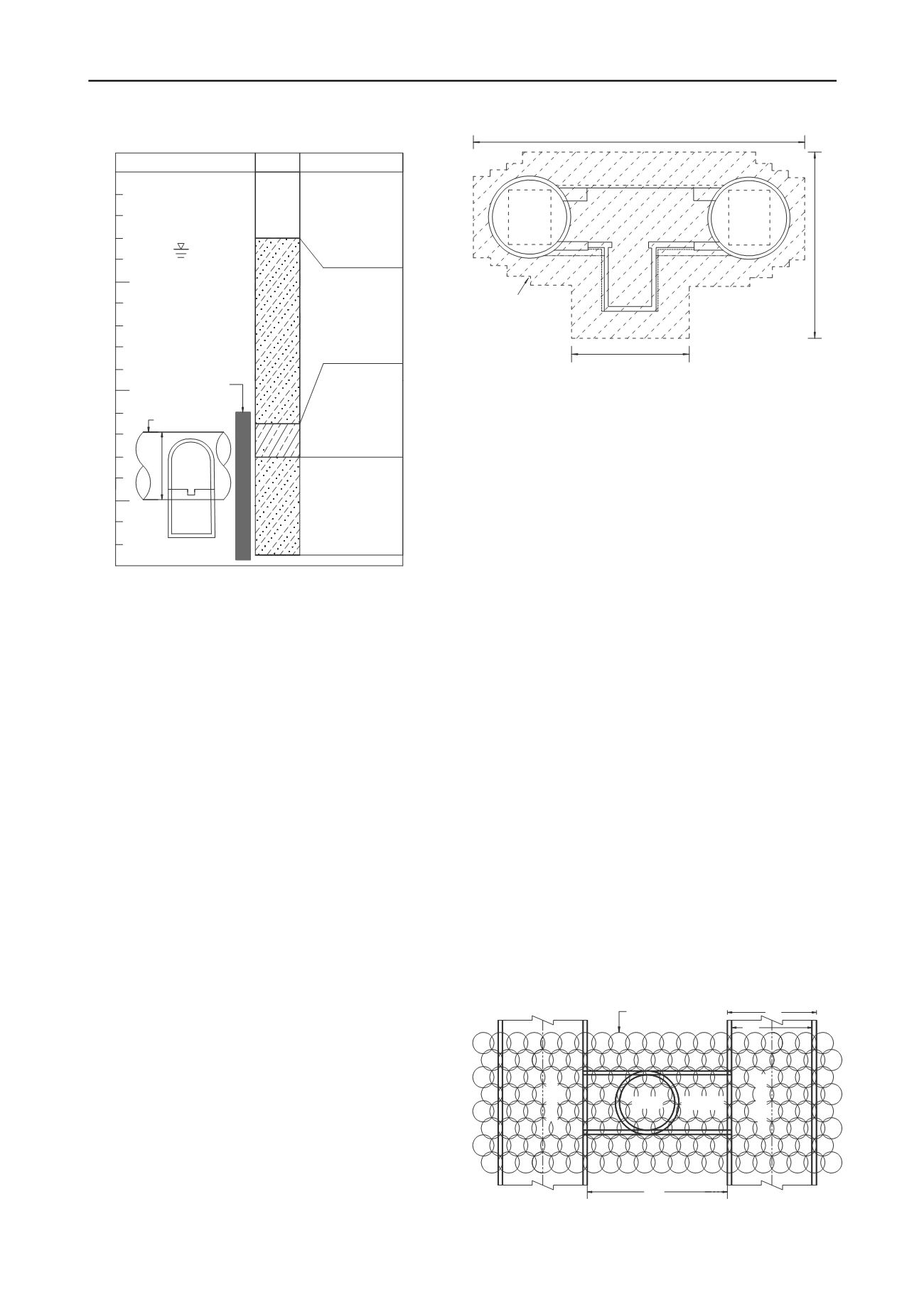
1700
Proceedings of the 18
th
International Conference on Soil Mechanics and Geotechnical Engineering, Paris 2013
Proceedings of the 18
th
International Conference on Soil Mechanics and Geotechnical Engineering, Paris 2013
Depth (m)
Boring log
SB-16
Description
10
GWT
Surface fill (CL)
N = 3-7
w = 17.9%
w
L
= 21
w
P
= 8
Sublayer V
Silty sand (SM)
N = 14-22
w = 20.2-27.3%
Sublayer IV
Silty clay (CL)
N = 14-22
w = 23.3-33.1%
w
L
= 22-46
w
P
= 2-20
Sublayer III
Silty sand (SM)
N = 16-23
w = 16.9-23.8%
6m
26m
35m
SF
23m
20
30
Jet
grouting
zone
sump
Drainage
Cross
passage
6.1m
Shield Tunnel
13.5 m
23.5 m
8.2 m
Down-Track
tunnel
Up-Track
tunnel
Cross passage
Drainage
sump
JSG soil
improvement
Down-Track
Tunnel
Up-Track
Tunnel
Cross
passage
JSG
= 1.4 m
Drainage
sump
5.6 m
6.1 m
9.4 m
Figure 2. Geological profile for excavation of cross passage and
drainage sump. (after Continental Engineering Corp., 2003)
1992), Figure 2 shows the geological profile adjacent to the
cross passage. In the figure, the groundwater table was at about
7 m below ground level.
Figure 2 shows the cross passage was constructed at the depth
of 24.7 to 29.3 m. Plus the 4.4 m-deep drainage sump, the
excavation was extended to the depth of 33.7 m. Soils excavated
for the cross passage included silty clay (classified as CL) and
silty sand (classified as SM). Engineering properties of these
soil deposits, such as the natural water content w, standard
penetration test blow count N, liquid limit w
L
and plastic limit
w
P
were indicated in Figure 2.
JSG (Jumbo Special Grout) operation was completed before
the shield machine arrived. Based on the size of the cross
passage and the recommendations of the Jet Grout Technical
Information (JJGA 1990), the grouting zone was 13.5 m-high,
and 8.2 to 23.5 m-wide as illustrated in Figure 3. Figure 4
shows a total of 168 1.4 m-diameter JSG piles were fabricated.
2.2
JSG operation and quality control
The technique of JSG utilizes high-pressure water-cement jet
streams (sheathed with air pressure) to cut, replace and mix with
native soils. For every 1 m
3
of jet grout, 600 kg of type I
Portland cement was mixed with 0.81 m
3
of water. The jetting
pressure was controlled at 19.6 MPa (200 kgf/cm
2
), and the rate
of flow was 0.06 m
3
/min. The air pressure used was 0.6 to 0.7
MPa (6 to 7 kgf/cm
2
). The grouting rod was controlled to rotate
at 6 to 7 r.p.m., and to uplift at the speed of 2.0 m/hr.
After ground improvement, soilcrete cores were drilled and
field permeability tests were carried out. The minimum core
recovery of 80% and the maximum coefficient of permeability
of 1 x 10
-7
m/s were required for the improved body. 28 days
after grouting, the design specification requires the uniaxial
compressive strength of sample obtained from sandy and clayey
layer should reach at least 2.94 MPa (30 kgf/cm
2
) and 0.98 MPa
(10 kgf/cm
2
), respectively. For more information regarding the
JSG application for the construction of Taipei MRT, the reader
is referred to Fang and Chung (1997), Fang and Yu (1998), and
Figure 3. Section of JSG ground improvement for cross passage.
Fang et al. (1993, 1994a, 1994b).
3 CONSTRUCTION OF CROSS PASSAGE
3.1
Preparation
Due to the pushing, cutting and disturbing of the cutter disc of
the EPB shield tunneling machine, cracks and discontinuities in
the improved ground might be induced. As a result, the
water-leak test on the jet-grouted body became necessary.
Figure 5 shows holes were drilled from the tunnel to the
soilcrete to investigate the quality of ground modification. The
holes should not penetrate the improved ground as to create new
intruding paths for groundwater. When a significant amount of
water-leak was measured in the tunnel (see Figure 6), additional
chemical grouting was conducted as indicated in Figure 7. Low
pressure grout with a mixture of water-glass and SL reaction
agent was injected to the improved ground to seal all water
paths around the cross passage.
To repress the inflow of groundwater at the face of
excavation, and to increase the safety of construction, the
compressed-air method was employed. The air-lock used is
shown in Figure 8. For most of the working days, the air
pressure was kept at 60 to 80 kPa, and the maximum air
pressure used was about 180 kPa.
For the mining of the cross passage, circular holes were cut
on the steel segments of the main MRT tunnels. The load
release on the opening would cause a redistribution of pressure
on the tunnel lining, and a possible stress concentration on
adjacent lining segments. For this reason, Figure 9 shows the
contractor fabricated octagonal steel reinforcements on both
sides of the opening in the tunnel for protection.
3.2
Excavation
The excavation of cross passage was conducted manually. The
digging was divided into four parts: (1) top heading (the upper
part); (2) bench (the middle part); (3) invert (the lower part);
Figure 4. Plan of JSG ground improvement for cross passage.


